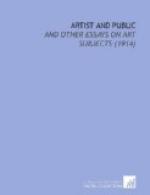The “Poetry” (Pl. 11) is the most beautiful of the medallions, but they are all much alike: a draped female figure in the middle, seated to give it scale, large enough to fill the height of the circle amply but without crowding, and winged putti, bearing inscribed tablets, on either side. There are other ways of filling a circle acceptably, as Botticelli had shown and as Raphael was to show again in more than one tondo, but for their situation, marking the principal axes of the room, there is no way so adequate as this. As Mr. Blashfield has said, speaking from experience: “When a modern painter has a medallion to fill and has tried one arrangement after another, he inevitably realizes that it is Raphael who has found the best ordering that could be found; and the modern painter builds upon his lines, laid down so distinctly that the greater the practice of the artist the more complete becomes his realization of Raphael’s comprehension of essentials in composition.” Not only so, but the modern painter finds as inevitably that, accepting this ordering as the best, even then he cannot add another figure to these four. He may, perhaps, draw it better in detail or give more character to the head, but he cannot capture that felicity of spacing, that absoluteness of balance, that variety and vivacity combined with monumental repose. The more his nature and training have made him a designer the more certainly he feels, before that single medallion of Poetry, that he is in the presence of the inimitable master of design.




